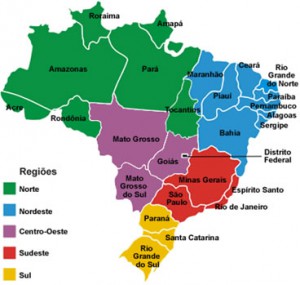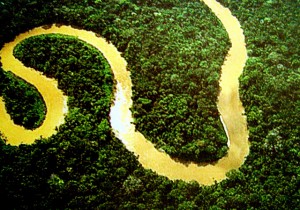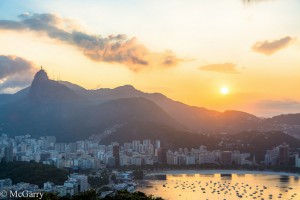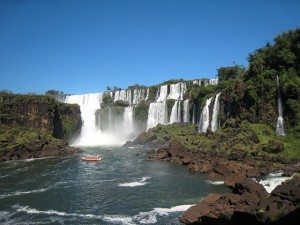Regiões (regions) do Brasil Posted by Ester on May 18, 2015 in Brazilian Profile, Culture, Customs, Economy, Geography, Video
In order to understand Brasil, the language and the culture it is important to know more about each one of the 5 regiões (regions).
Brasil has 27 unidades federativas (federative units):
* 26 estados (states)
* 1 Distrito Federal (Federal District)
The country is divided in 5 regiões: Norte (North), Nordeste (Northeast), Centro-oeste (West-Central), Sudeste (Southeast) and Sul (South).
Each estado has its own characteristics, culture and some independence to create its own leis (laws) nowadays. When the portugueses colonized Brasil they granted land to Portuguese noblemen or merchants to colonize the land. These lands were called capitanias hereditárias (hereditary captaincies) and the devision of these lands evolved into the estados we have now. Even though the capitanias hereditárias were ruled by different people they would still ultimately have to answer to the Coroa Portuguesa (Portuguese crown).
Only in 1969 did Brasil finally shape the regiões, its estados and capitais to what they are today.
Norte: it is the biggest in Brasil (45.2% of the land) and the smallest população. The equatorial climate makes it hot and humid all year long and most of the região is covered by Amazon Rainforest. Because of the late occupation by the Portuguese, this região has many comunidades indígenas (indigenous communities) as well as a very preserved ecosystem, which makes ecotourism the main form of tourism. Even though tourism is a big part of the economy there, this região is also greatly responsible for energy production as well as the manufacturing of electronic goods due to the fact that it has a free economic zone called Zona Franca de Manaus.
Curiosity: if you own or have access to any electronic goods made in Brasil, check the back of it for where it was made. The chances of it being made in Zona Franca de Manaus are big.
Nordeste: it is the third region in size in Brasil (18.2% of the land) and the second biggest população. This was where the Portuguese first set foot in Brasil and where the first capital was: the city of Salvador, in Bahia. Even though the climate is tropical climate near the coast, it is semi-arid in the interior, creating big water supply issues for the população e colheita (population and crops). Nordeste is also the most impoverished region as it has the lowest levels in nearly all the social indicators. It has, however, an immensely rich culture: carnaval, forró (a type o dance/music), cordel (a type of literature) and much more. The poverty and the lack of rain in some areas of Região Nordeste had great cultural influence in music and literature. An example would be this very well-known song called Asa Branca, which is all about the migration to other regions for the hope of a better life.
Centro-Oeste: it is the third biggest região (18.8% of the land) and it has the second smallest population. Most of the land in this region is used for gado e agricultura (grazing and agriculture). It is the least industrialised região in Brasil and it is based on food and meat processing. This is the região with the most indigenous groups and parques nacionais (national parks) created to protect the meio-ambiente (environment) as well as the indigenous groups in the area. The Chapada dos Guimarães is the parque nacional which attracts the most turistas for its exquisite nature, rock formation, caves and waterfalls. Website for tourism: http://www.chapadadosguimaraes.com.br
Sudeste: it is the second smallest region in Brasil (10.85% of the land) and the most populosa (populous one). This is the economic centre of Basil and most big companies have their headquarters there, this is the reason why it is also the region with the two most known cities:
* Rio de Janeiro attracts the most turistas for many reasons such as its international fame, the beaches, the Cristo Redentor (Christ the Redeemer statue), the Carnaval, amongst others.
*São Paulo: the biggest city in the country and the 12th most populous one in the word.
The state of Minas Gerais the biggest estado in this região, it is known for its gastronomy and it is one of the main destinations for tourists who are interested in história.
Sul: it is the smallest região with only three estados and it is the third most populosa. This is the only região where snow is relatively common, especially in the high lands. Região Sul has a better standard of living with the best social indicators, melhor educação e sistema de saúde (best education and health system). There is strong immigrant presence descended from Europeans, which has greatly influenced the culture, cosine as well as architecture. From a tourism point of view there are many beautiful beaches, historic places and museums, not to mention the famous Cataratas do Iguaçu (Iguazu Falls).
In Brasil we usually say existem muitos Brasis em um (there are many Brazils in one), meaning that when it comes to people, culture, economy, tourism, development and many other topics, Brasil is incredibly vast.
Agora vá explorar e se apaixonar por todos os cantos deste país incrível! Now go explore and fall in love with every corner of this amazing country!

Build vocabulary, practice pronunciation, and more with Transparent Language Online. Available anytime, anywhere, on any device.







